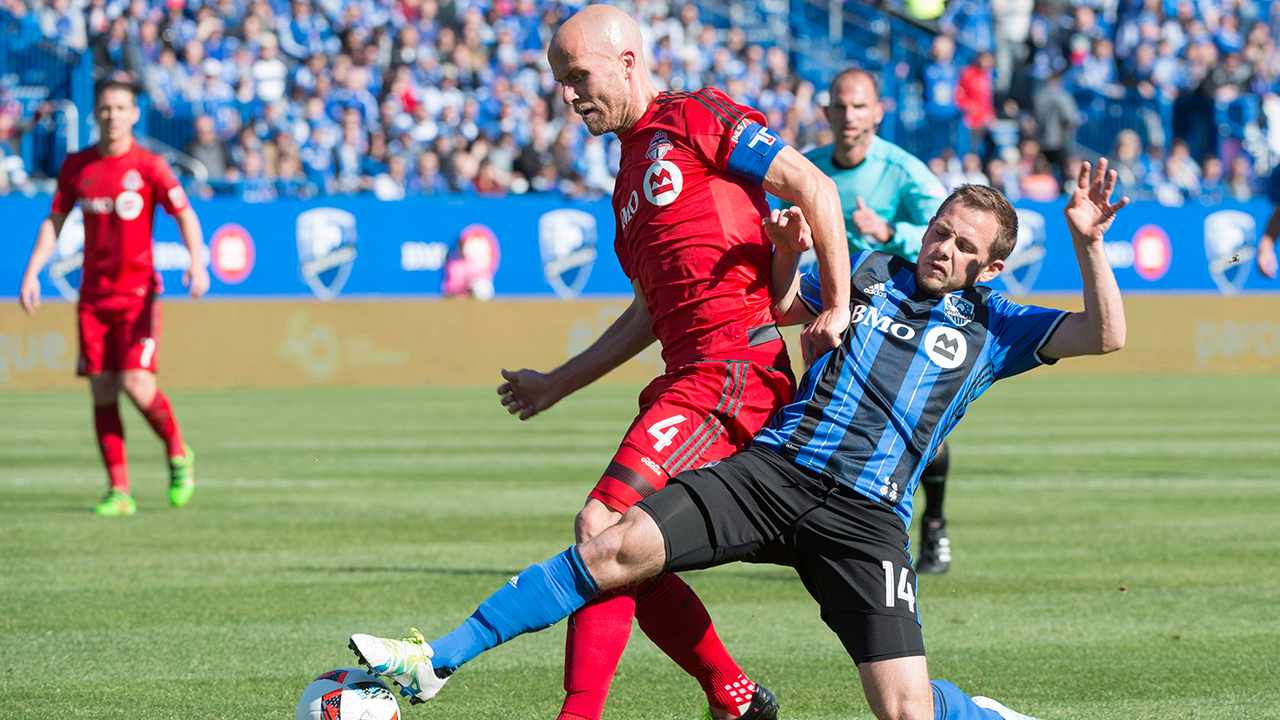TORONTO – Would it surprise you to learn that Toronto FC’s defence has scored more goals than its midfield?
Through the first 29 games of the Major League Soccer campaign, TFC midfielders have scored six of the team’s 44 goals (14 percent of the offence) while defenders have found the back of the net seven times (16 per cent).
Marky Delgado and Will Johnson each have two goals, and Michael Bradley and Jonathan Osorio have one apiece. Defenders Drew Moor and Justin Morrow both have three goals, good enough to rank third in team scoring, alongside forward Jordan Hamilton. TFC’s midfield is well off the pace of last season’s goal totals when six different players combined to score 14 times.
It raises the obvious question: How come Toronto’s midfielders aren’t scoring as much?
Coach Greg Vanney explained that the midfield’s decreased offensive production is largely a result of TFC changing its focus this season on being a better defensive and organized team. You’ll recall that the Reds conceded 58 goals in 2015, tied for the worst defensive record in the league. At the moment, Toronto boasts the third-best defence in MLS, with 32 goals against. That’s not entirely down to the defenders; the midfielders have played a major role in the team’s improved defensive record, too.
“Our midfield has held their shape a little bit more [this year], been a little more disciplined to prevent us from being opened up on the counter-attacks, so we’ve been less likely to just send [midfielders] into the box,” Vanney said ahead of Saturday evening’s home game against the Philadelphia Union.
“Last year we were scoring a ton of goals but we were also conceding a boatload of goals in transition in some situations where we weren’t holding our shape properly.”
Bradley’s new assignment is a perfect example of the Reds’ change in overall focus.
The veteran midfielder scored five goals in 2015, and took over 50 shots in each of the last two seasons, with 29 of them on target. Bradley is on pace to play practically the same number of games this campaign as he has in each of the past two years, but his offensive stats have dropped off drastically. The TFC captain has taken only nine shots (two on target), and his first goal of the year came in last weekend’s 3-3 draw against the New York Red Bulls.
“He’s playing in a deeper role in midfield, and his role for us this year is to more connect the [defence] into the attack, that first phase of attack,” Vanney explained. “On the defending side, [he’s had to be] a little bit more accountable to defending some of the spaces in transition and protecting our back group.
“Inherently, he ends up in slightly deeper positions than he has in the last couple of years. [In 2015) he was more of the attacking midfielder in the diamond, so we were asking him to get through gaps and to get himself into goal-scoring positions. That’s the main reason why he’s had less [shot] attempts this year.”
Vanney also pointed to the fact that Toronto as a team tries to break into the box in order to score with greater consistency than taking shots from outside the 18-yard area.
“I do think our shooting from a distance hasn’t been great. … In general, as a team we’re scoring more goals in closer to the [opponent’s net] this year and less goals outside of the box, and that’s usually where midfielders tend to [score],” Vanney said.
He later added that the midfield has done a very good job of feeding forwards Sebastian Giovinco and Jozy Altidore, who have combined to score 24 times this season.
That’s not to say Vanney wouldn’t mind seeing his midfielders chipping in with a few more goals, though. Bradley’s strike against New York last weekend came about after the TFC captain started a sweeping attacking movement by the team with a simple pass and ended with him thumping the ball into the net after making a run from deep.
Vanney wants to see Bradley make more attacking runs from deep positions like the one he made against New York. He doesn’t want his captain to run around and look for the occasion, but rather recognize the opportunity when it comes, and not be afraid to play on the fringe of finding the right moment to attack, instead of just sitting and protecting the defence.
“I spoke to him after the game just about what [he saw] in that moment where he broke through and ended up scoring. … It was an encouragement on my part to say to him, ‘if you see these moments then go,” Vanney said.
“If he sees it, as he did in that situation, then he should go, because him arriving into the box is one of the great strengths that he has that we can utilize.”
In comparing the number of goals the midfield scored in 2016 vs. 2015 it’s also important to keep in mind the overall state of those two teams. Last year, TFC just managed to qualify for the playoffs. This year, they’re contending for first place in the Eastern Conference and for the Supporters’ Shield. Toronto’s midfield is scoring less, but there’s no question that this a better and more balanced side than last year’s version.
“Last year the midfield scored more than they have this year, and yet they finished as the sixth-place team [in the East] and now we’re the first-paced team,” Johnson offered.

Sportsnet’s Soccer Central podcast (featuring James Sharman, Thomas Dobby, Brendan Dunlop and John Molinaro) takes an in-depth look at the beautiful game and offers timely and thoughtful analysis on the sport’s biggest issues.








